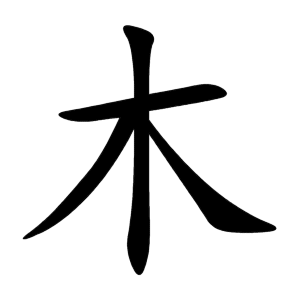木
- tree;
- wood, wooden;
Etymology
木 is a pictograph symbolizing a tree with roots spreading out. The ancient form shows the root and the trunk bent symmetrically, differing mostly in size but forming an almost vertical mirror image.
Most characters using the 木 radical relate to trees or wood. Along with the "three water dots" radical (氵) and the "grass head" radical (艹), it is widely used.
It corresponds to one of the Five Elements (五行) in East Asian philosophy, as in 木星 (Jupiter, “wood star”) and 木曜日 (Thursday, “wood day”).
Some linguists argue that the Korean word 나무 (namu, meaning "tree") may have etymological ties to ancient Chinese pronunciations, suggesting loanword influences in native Korean vocabulary.
If you add a horizontal stroke at the bottom (the roots) of 木, it becomes 本 (meaning "root" or "origin"). This is an ideogram indicating that the root is the fundamental part of the tree. For example, the name of the country Japan (日本) literally means "the origin of the sun," or "where the sun rises."
If you add a short horizontal stroke near the top (the branches) of 木, it becomes 未 (meaning "not yet" or "still unripe"). If you add a longer horizontal stroke near the top, it becomes 末 (meaning "end" or "tip").
未 in oracle bone script shows additional small branches on the top of 木, representing a summer fruit tree with many branches and leaves but not yet bearing fruit.
While 不 (no, not) and 非 (wrong, not) represent simple negation, 未 carries the nuance of "not yet" or "still not done."
末 first appears in bronze script (not oracle bone script), with an extra stroke added to the very top of 木, indicating the "top end" of the tree.
Some interesting related characters are:
林 (two 木 characters side by side) meaning "grove" or "small forest."
森 (three 木 characters) meaning "forest," conveying the sense of many trees densely packed.
There are also more complex characters made in this manner, such as 𪚥, which uses four 龍 (dragon) characters.
Additional notes
In Hong Kong and Taiwan, when 木 is at the bottom of a character, it is written as 朩 without a hook instead of 木 itself.
Derived characters
There is a related character 樹 (tree, living tree). 樹 usually refers to a living tree (e.g., street tree), or categories of trees (e.g., broadleaf or coniferous trees).
木 can refer to biological species of trees (e.g., boxwood, lucky tree), dead wood (old tree), or wood material used for construction or instruments (e.g., timber, wooden structures, woodwind instruments).
Characters with 木
- 杯–cup, goblet, vessel for drinking
- 東–east, the eastern direction
- 松–pine tree
- 板–plank, board, panel
- 析–to split, to divide, to separate, to analyze, to distinguish, to break apart
- 林–forest, grove, woods
- 枚–single, piece, stem
- 果–fruit, result, outcome, decisive, resolute
- 枝–branch, twig, offshoot, to divide, to branch out
- 架–rack, stand, prop, frame, framework
- 柄–handle, shaft, grip, authority, control
- 某–someone, a certain person, anonymous reference
- 柔–soft, gentle, pliant, yielding, mild
- 查–to examine, inspect, investigate, to check
- 柱–pillar, post, column, to support, to hold up
- 査–to investigate, to examine, to check, to look into
- 棄–to abandon, to discard, to give up, to throw away
- 棋–board game, chess, Go
- 棟–ridgepole, the main beam of a house
- 森–forest, woods, grove, dense, thick
- 棷–a kind of tree, wood for fuel, hemp rod
- 棺–coffin, casket
- 椅–chair, seat
- 植–to plant, to set up, to grow
- 極–to the utmost, to exhaust, extreme, ultimate, end, utmost point
- 槪–roughly, generally, on the whole, outline, broad measure
- 樂–music, song, joy, pleasure, delight, to like, to enjoy
- 樊–fence, enclosure, paling
- 標–to mark, to indicate, a sign, a standard, a high branch or treetop
- 樞–hinge, pivot, axis
- 模–to model after, to copy, to form, pattern, model, style, mold
- 樣–form, appearance, shape, manner, pattern
Words that derived from 木
- 木 (D)
- ⿻ 十 𠆢
